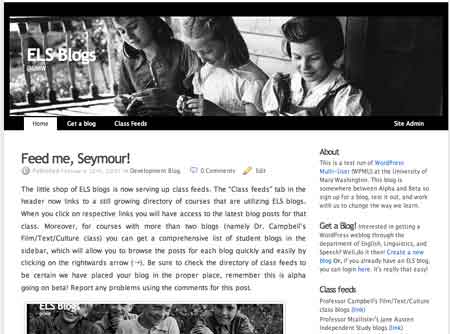OK, so I am gonna have to earn my keep during my stay up North, for the folks of Northern Voice have been nothing but golden thus far. In particular, I want to give a gigantic shout out to Brian Lamb– who has bent over backwards to make sure that everything runs smoothly during my stay, as I am sure he is for the 250 other folks attending. He is redefining the limits of hospitality -and I will be sure to try and push those boundaries even further upon my arrival;) Thanks for everything, Brian!
So I finally got around to thinking about the Moose Camp and how I might be able to share some of the fun work we have been doing at UMW. So, I wrote up a rough proposal in the open NV wiki , that originally focused on WordPress as a Content Management System. About an hour after I posted this to the wiki Alan swept in and helped me re-frame the proposal by leaving key links to other blogs (not just WordPress) that have been re-purposed for various uses above and beyond the blog (I particularly like his More than Cat Diaries as well as the NMC Virtual Worlds site. So, an hour after posting my rough ideas I already have resources, and an ongoing collection of del.icio.us links via Alan. But that’s not it, soon after D’Arcy stops by and says the following:
Jim – I’d be happy to demo some Drupal stuff. Should we expand the title to not be so WP-centric? This ain’t your fathers blogging platform. 🙂
So not only have I been given key resources on the topic I proposed, but soon after that the CMS gauntlet is thrown at my feet. D’Arcy calls me out for being such a WordPress groupie, and promises to keep me honest. How cool is this? So, I go back to the wiki today -because that’s what I do now- and I see that Candace, who has proffered a topic on distinguishing between wikis, blogs and CMSs, has struck her proposal in order to integrate it more directly with this one. So, now there are four of us involved in thinking through blogs, wikis and CMSs more broadly than I originally imagined, while at the same time each of us can draw from the specifics of our own varied experiences with each of these tools. This is the promise of social networks in living color. Four people, separated by thousands of miles and a million and one other things to do, are cobbling together the framework for an informal presentation at an un-conference that is embedded in the very process that we are working through. Even if I get hit by a bus tomorrow (luckily there are no buses in Fredericksburg), I could still say that NV has lived up to its ideal of fostering the possibilities of these small, meaningful connections between people and ideas.
This brings me to my next point, I am a bit worried that my over zealousness about using WordPress as a CMS to re-frame teaching and learning may focus too much on the technicalities of WordPress. Originally, I thought it would be cool to create a WordPress Multi-User install, and have the participants work together to create their own website/youtube/flickr-like spaces using a few hacks, K2, and some widgets. But after reading a few comments on the wiki and looking at past NV conferences, I think the genius of this conference is its focus on the human, rather than the technical, element of blogging. It has already been humanized further by three people’ contributions that helped me re-think my insistence on a specific application or tool. I believe, for my part, I need to focus on what makes working through the particulars of WP or K2 of any value to the larger questions surrounding blogging. What does such a proposal offer the folks who will be participating? Is this an opportunity to re-think the limits and possibilities of the blog? Or, maybe it’s way to understand the human forces behind blogging as part of a larger, more powerful movement to re-define publishing more generally? Do we need to re-conceptualize blogs within a larger framework of individuals publishing within several mediums with overlapping modalities as key to tracing the radical changes in the realm of authorship and publishing we are witnessing all around us?
“Can I get a witness?!!”
What do you think about these questions? Too much? Too little? Just right? More importantly, what would you consider an essential part of the “human element” (sorry for this term) of thinking through wikis, blogs and CMSs? I really would like to know -for I don’t want to miss the forest for all the beautiful WordPress trees.


 All right, I have to blog about this again because I really think we are there. It all may need a little fine-tuning but not that much. I have been talking about
All right, I have to blog about this again because I really think we are there. It all may need a little fine-tuning but not that much. I have been talking about 

